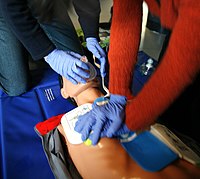
Photo from wikipedia
Background Exhaled carbon dioxide (CO2) reflects cardiac output (CO) provided stable ventilation and metabolism. Detecting CO changes may help distinguish hypovolemia or cardiac dysfunction from other causes of haemodynamic instability.… Click to show full abstract
Background Exhaled carbon dioxide (CO2) reflects cardiac output (CO) provided stable ventilation and metabolism. Detecting CO changes may help distinguish hypovolemia or cardiac dysfunction from other causes of haemodynamic instability. We investigated whether CO2 measured as end-tidal concentration (EtCO2) and eliminated volume per breath (VtCO2) reflect sudden changes in cardiac output (CO). Methods We measured changes in CO, VtCO2, and EtCO2 during right ventricular pacing and passive leg raise in 33 ventilated patients after open heart surgery. CO was measured with oesophageal Doppler. Results During right ventricular pacing, CO was reduced by 21% (CI 18–24; p < 0.001), VtCO2 by 11% (CI 7.9–13; p < 0.001), and EtCO2 by 4.9% (CI 3.6–6.1; p < 0.001). During passive leg raise, CO increased by 21% (CI 17–24; p < 0.001), VtCO2 by 10% (CI 7.8–12; p < 0.001), and EtCO2 by 4.2% (CI 3.2–5.1; p < 0.001). Changes in VtCO2 were significantly larger than changes in EtCO2 (ventricular pacing: 11% vs. 4.9% (p < 0.001); passive leg raise: 10% vs. 4.2% (p < 0.001)). Relative changes in CO correlated with changes in VtCO2 (ρ=0.53; p=0.002) and EtCO2 (ρ=0.47; p=0.006) only during reductions in CO. When dichotomising CO changes at 15%, only EtCO2 detected a CO change as judged by area under the receiver operating characteristic curve. Conclusion VtCO2 and EtCO2 reflected reductions in cardiac output, although correlations were modest. The changes in VtCO2 were larger than the changes in EtCO2, but only EtCO2 detected CO reduction as judged by receiver operating characteristic curves. The predictive ability of EtCO2 in this setting was fair. This trial is registered with NCT02070861.
Journal Title: Critical Care Research and Practice
Year Published: 2019
Link to full text (if available)
Share on Social Media: Sign Up to like & get
recommendations!